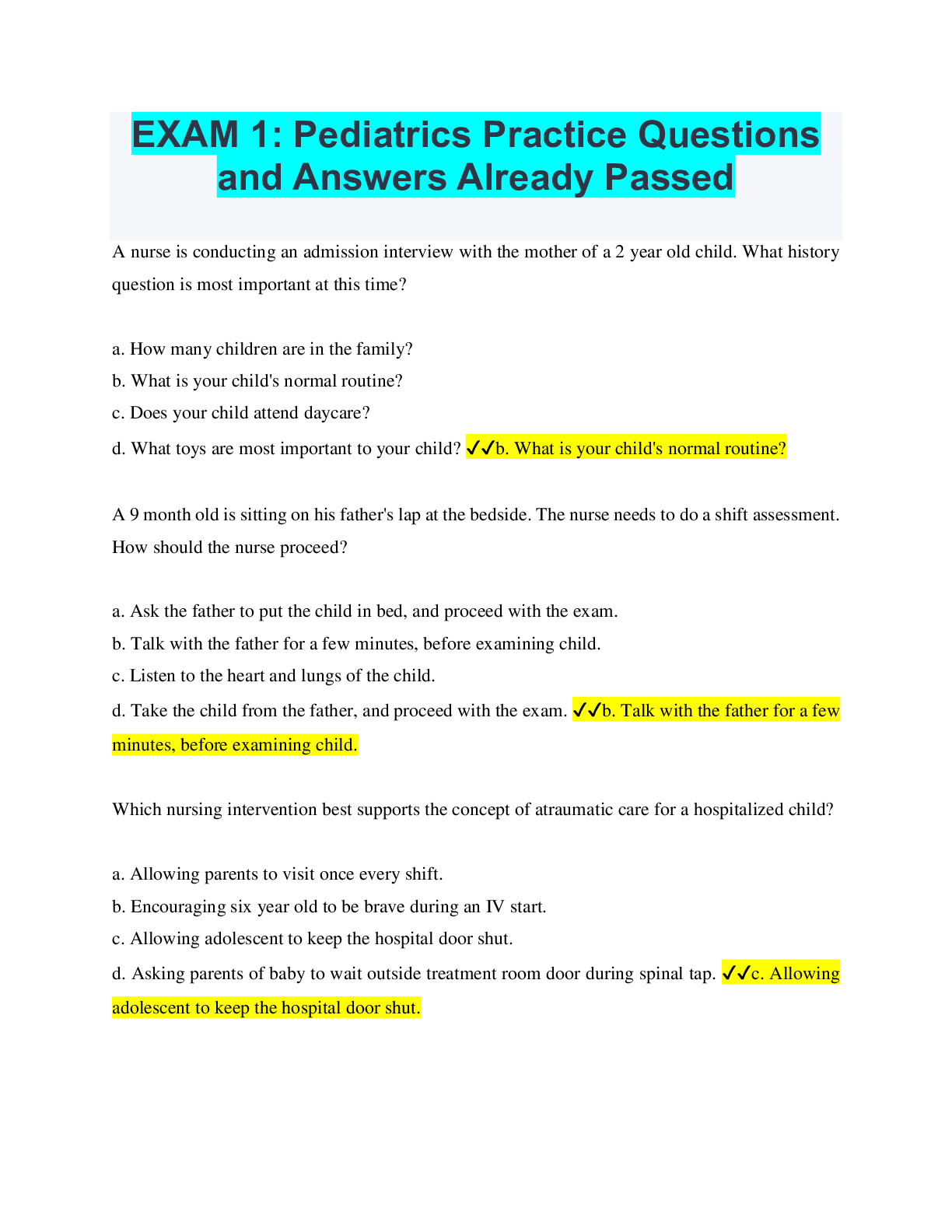*NURSING > QUESTIONS & ANSWERS > 1600 ATI Pediatrics Practice Questions & Answers (latest 2021/2022) (All)
1600 ATI Pediatrics Practice Questions & Answers (latest 2021/2022)
Document Content and Description Below
A nurse is collecting data from a 9-month-old infant. Which of the following findings would require further intervention? Rationale: The Babinski reflex disappears after 1 year of age. Therefore, a ... 9-month-old infant with a positive Babinski reflex is a finding that does not require further intervention. A. Positive Babinski reflex Rationale: The Moro reflex disappears approximately at 3-4 months of age. Therefore, a 9- month-old infant with a positive Moro reflex is a finding that requires further intervention B. Positive Moro reflex Rationale: A negative Doll’s eye reflex is a normal finding. Therefore, a 9-month-old infant with a negative Doll’s eye reflex is a finding that does not require further intervention. C. Negative Doll’s eye reflex Rationale: A negative Crawl reflex disappears after 6 months of age. Therefore, a 9-month-old infant with a negative Crawl reflex is a finding that does not require further intervention. D. Negative Crawl reflex 1. A nurse is reinforcing teaching a parent of a child who has a fracture of the epiphyseal plate. Which of the following is an appropriate statement by the nurse? Rationale: Children heal fractures in less time than adults because of the generous blood supply to the bone and the epiphyseal plate. A. “The blood supply to the bone is disrupted.” Rationale: A fracture of the epiphyseal plate can affect growth in a child. Therefore, it needs to be detected and treated rapidly. B. “Normal bone growth can be affected.” Rationale: The epiphyseal plate is the cartilage growth plate. Therefore, bone marrow is not lost through this type of fracture. C. “Bone marrow can be lost though the fracture.” Rationale: Children heal fractures in less time than adults because of the generous blood supply to the bone and the epiphyseal plate. D. “The healing process will take longer.” 2. CAA_DetailedAnswerKey created 10/05/2012 page 1 of 18 Detailed Answer Key Homework 8 - Pediatrics A nurse is planning to speak to a group of adolescents about toxic shock syndrome (TSS). The nurse knows that TSS is commonly associated with which of the following? Rationale: Toxic shock syndrome, a severe disease caused by a toxin made by Staphylococcus aureus, is characterized by shock and multiple organ dysfunction. It most often affects menstruating women who use highly absorbent tampons. A. High-absorbency tampons Rationale: Mosquito bites are not associated with TSS. B. Mosquito bites Rationale: International travel is not associated with TSS. C. International travel Rationale: TSS is not associated with multiple sexual partners. D. Multiple sexual partners 3. A nurse is collecting data from an infant. Which of the following is a clinical manifestation of pyloric stenosis? Rationale: Visible gastric peristaltic waves moving from the left to the right are a clinical manifestation of pyloric stenosis. A. Absent bowel sounds Rationale: Vomiting causes a depletion of fluid and electrolytes, therefore a decrease in serum sodium levels is a clinical manifestation of pyloric stenosis. B. Increased sodium level Rationale: Pyloric stenosis is a narrowing and thickening of the pyloric canal between the stomach and the duodenum resulting in projectile vomiting. C. Projectile vomiting after feedings Rationale: An olive-shaped mass is palpable right of the umbilicus is a clinical manifestation of pyloric stenosis. D. Golf ball-sized mass over the left quadrant 4. CAA_DetailedAnswerKey created 10/05/2012 page 2 of 18 Detailed Answer Key Homework 8 - Pediatrics A nurse is planning care for a child who has juvenile rheumatoid arthritis. Which of the following is an appropriate action for the nurse to take? Rationale: NSAIDs are used to control pain. Therefore, administering opioids on a schedule is not an appropriate action for the nurse to take. A. Administer opioids on a schedule. Rationale: Physical mobility will assist in preserving function and maintaining mobility. Therefore, prolonged periods of complete joint immobilization is not an appropriate action for the nurse to take. B. Schedule prolonged periods of complete joint immobilization daily. Rationale: Heat is beneficial for relieving pain and stiffness. Therefore, applying cool compresses for 20 minutes every hour is not an appropriate action for the nurse to take. C. Apply cool compresses for 20 minutes every hour. Rationale: Maintaining night splints to the affected joints will assist in range of motion. Therefore, this is an appropriate action for the nurse to take. D. Maintain night splints to the affected joint. 5. CAA_DetailedAnswerKey created 10/05/2012 page 3 of 18 Detailed Answer Key Homework 8 - Pediatrics A nurse is caring for a school-age child who has mild persistent asthma. Which of the following is an expected finding? (Select all that apply.) A. Symptoms are continuous throughout the day. B. Daytime symptoms occur more than twice a week. C. Nighttime symptoms occur approximately twice a month. D. Minor limitations occur with normal activity. E. Peak expiratory flow (PEF) is greater than or equal to 80% of the predicted value. 6. Rationale: Symptoms are continuous throughout the day is incorrect. Continual asthma symptoms throughout the day are seen with severe persistent asthma. Daytime symptoms occur more than twice a week is correct. A child with mild persistent asthma will typically have daytime symptoms more than twice a week, but not daily. Nighttime symptoms occur approximately twice a month is incorrect. Nighttime symptoms occurring approximately twice a month are seen with intermittent asthma. Minor limitations occur with normal activity is correct. A child with mild persistent asthma will have some minor limitations with normal daily activities. Peak expiratory flow (PEF) is greater than or equal to 80% of the predicted value is correct. A child with mild persistent asthma will have a PEF greater than or equal to 80% of the predicted value. CAA_DetailedAnswerKey created 10/05/2012 page 4 of 18 Detailed Answer Key Homework 8 - Pediatrics A nurse working in a pediatric clinic is collecting data on a preschool-age child who has a rash on his arm. The mother reports that the child was recently exposed to impetigo contagiosa. Which of the following manifestations should the nurse expect to find with this skin infection? Rationale: This finding is associated with tinia corporis (ringworm), not impetigo. A. Scaling patches that are clear in the center. Rationale: This finding is associated with impetigo contagiosa. Honey-colored crusts develop when vesicles rupture and the exudate dries. B. Honey-colored crusts caused by dried exudate. Rationale: This finding is associated with verruca (warts), not impetigo. C. Firm papules with a roughened, finely papillomatous texture. Rationale: This finding is associated with poison ivy, not impetigo. [Show More]
Last updated: 1 year ago
Preview 1 out of 92 pages
Instant download
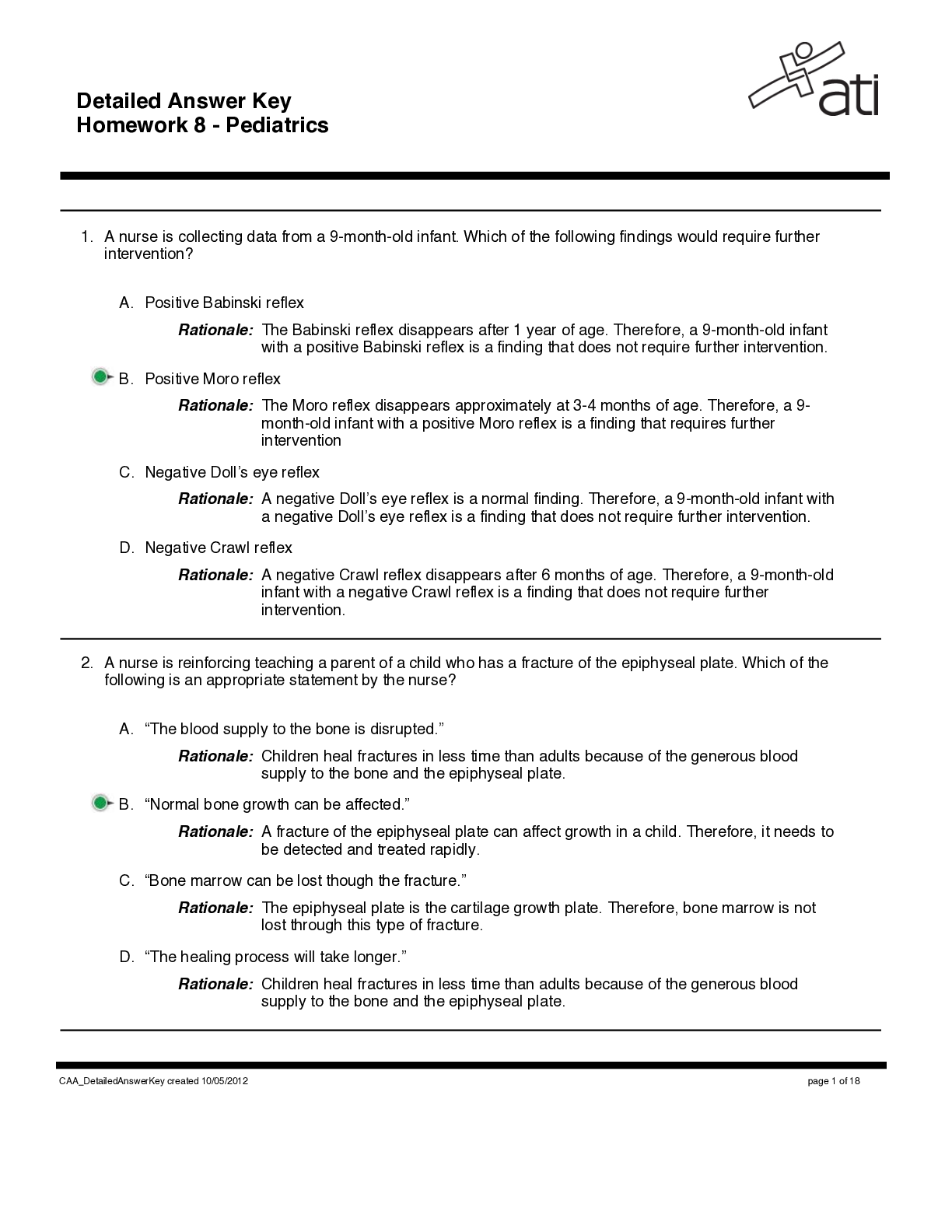
Buy this document to get the full access instantly
Instant Download Access after purchase
Add to cartInstant download
Reviews( 0 )
Document information
Connected school, study & course
About the document
Uploaded On
Apr 21, 2022
Number of pages
92
Written in
Additional information
This document has been written for:
Uploaded
Apr 21, 2022
Downloads
0
Views
55





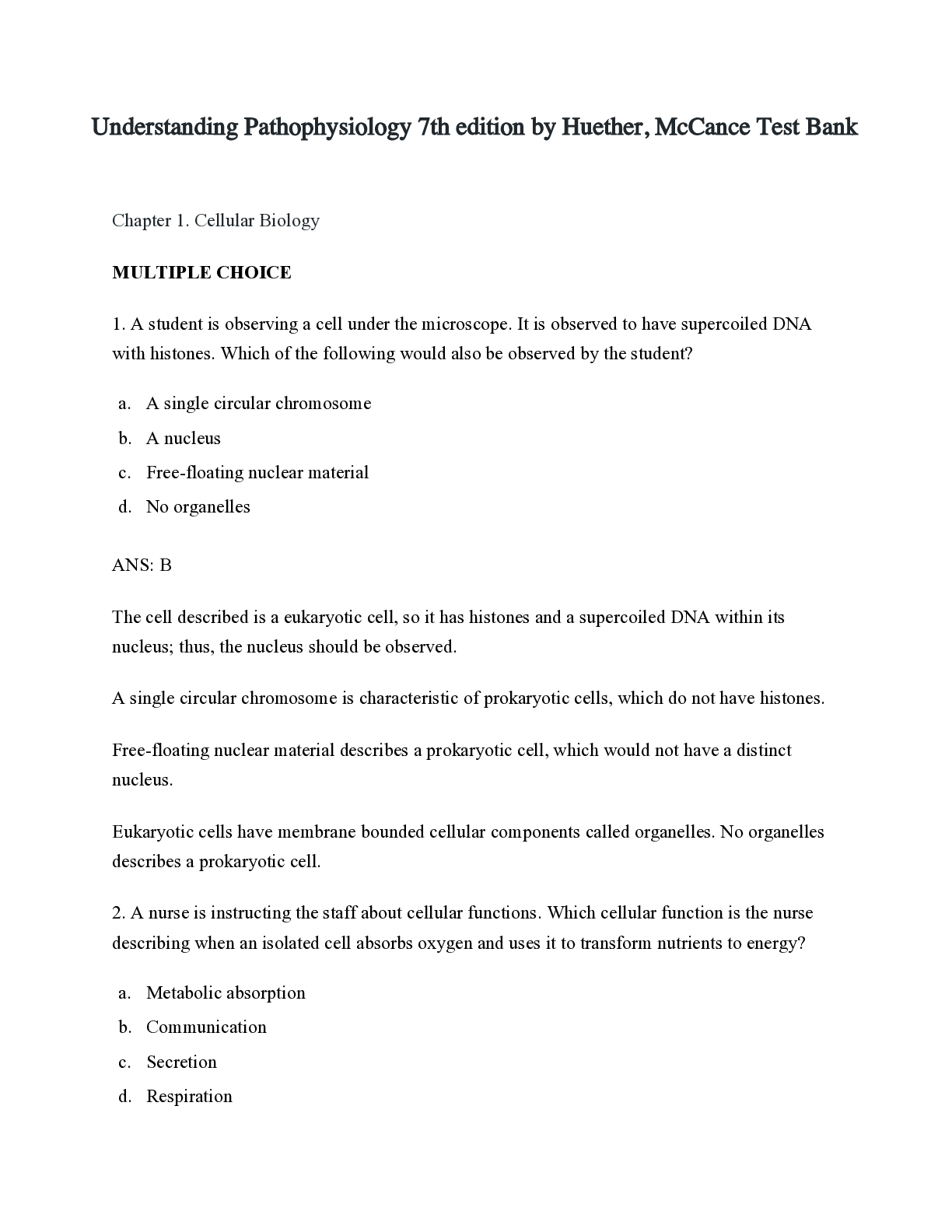
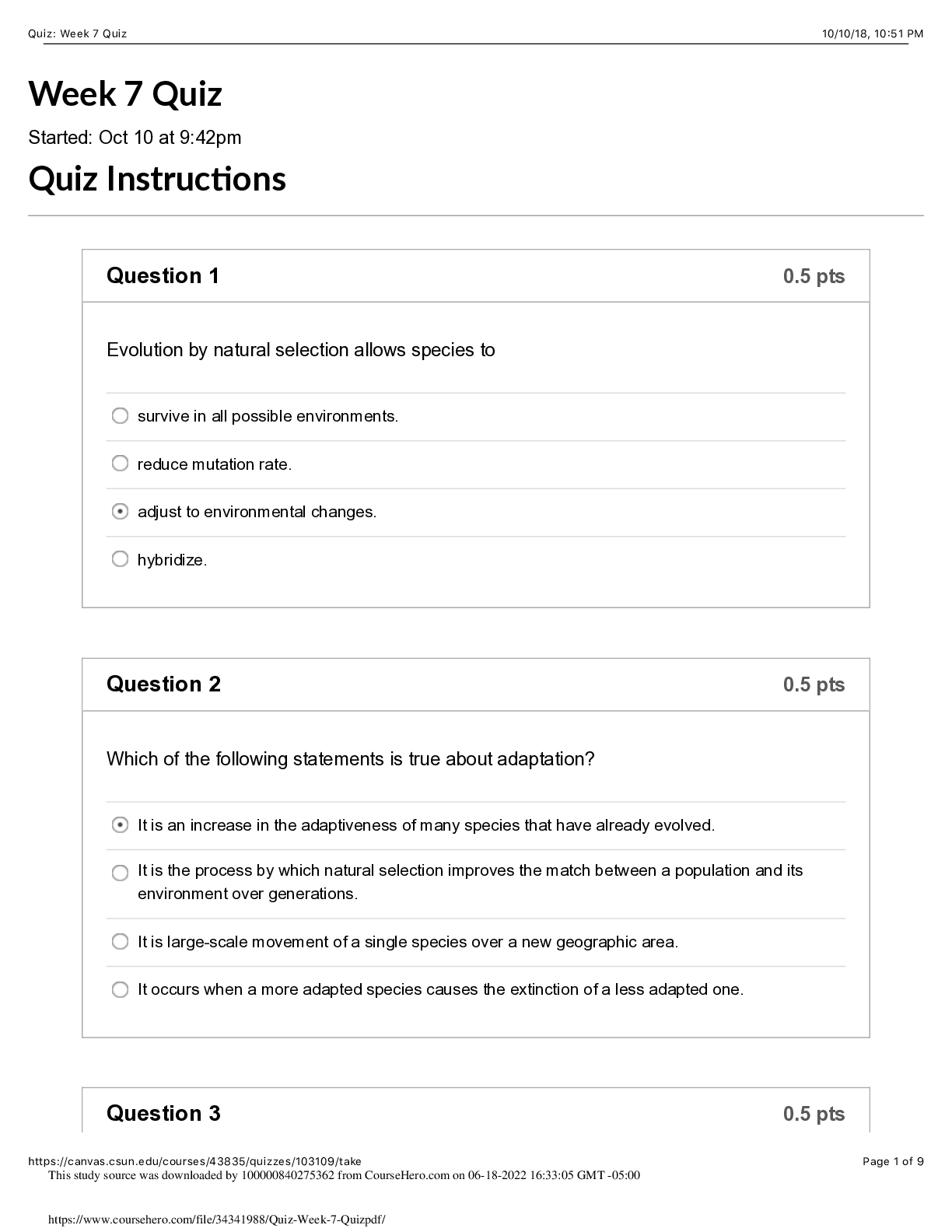
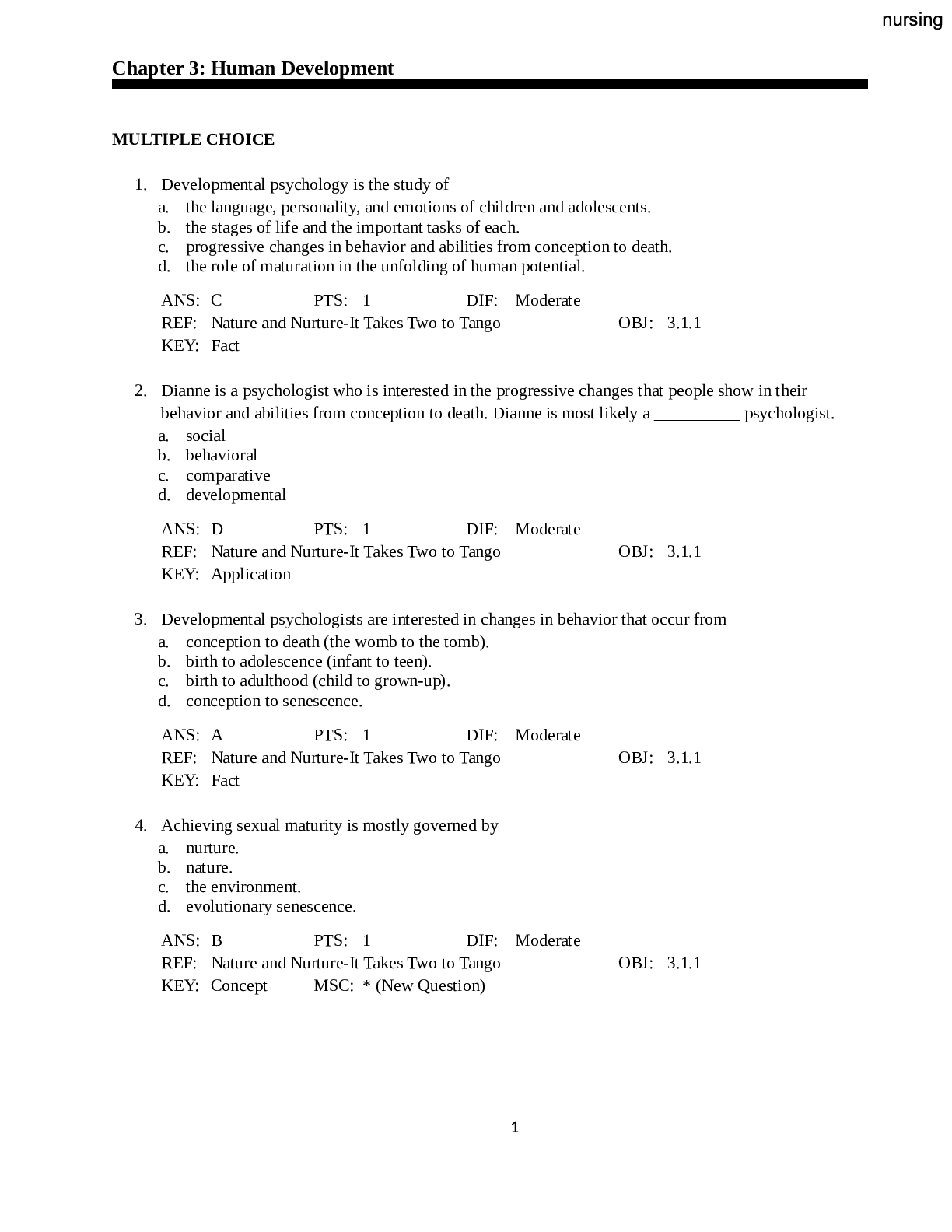
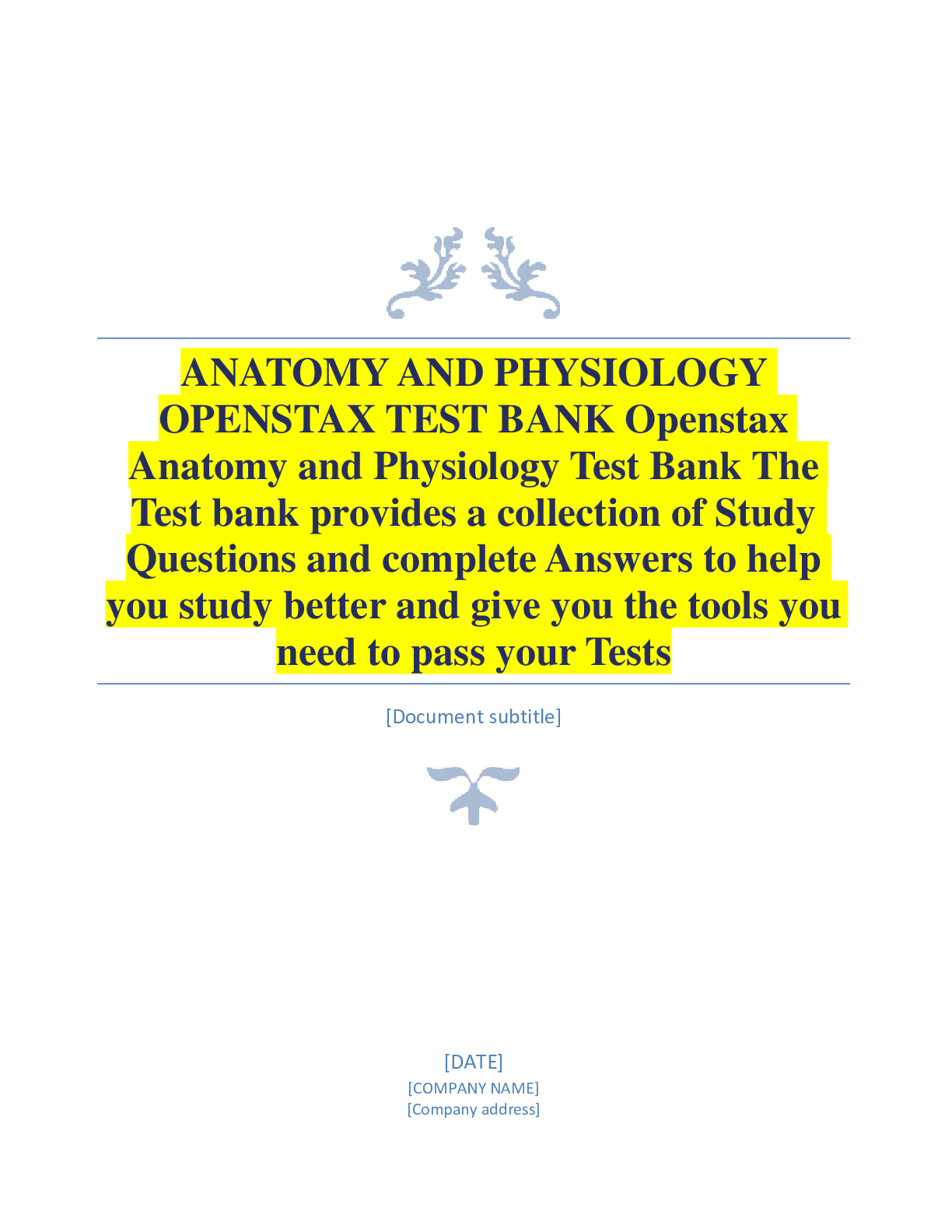
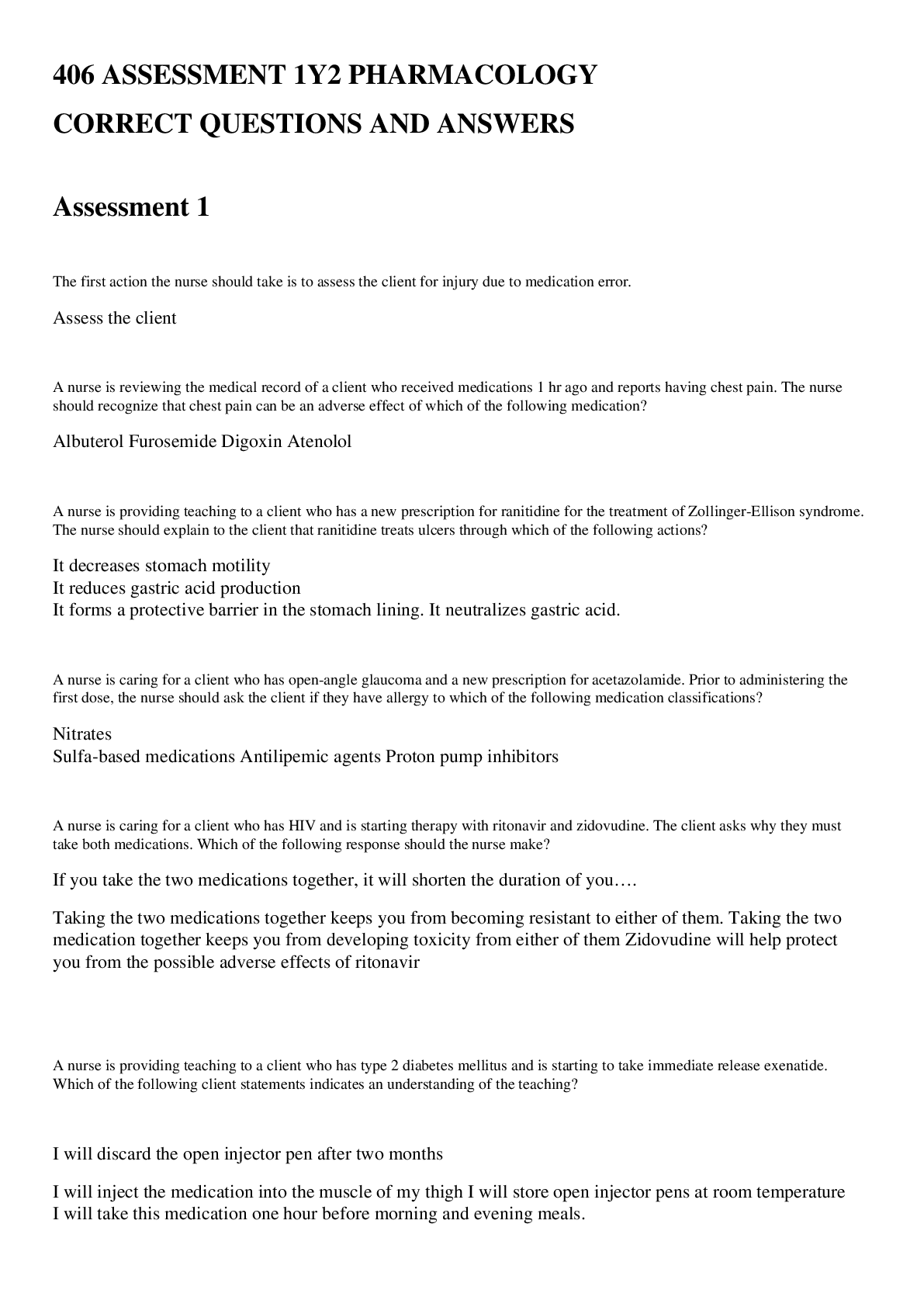
.png)
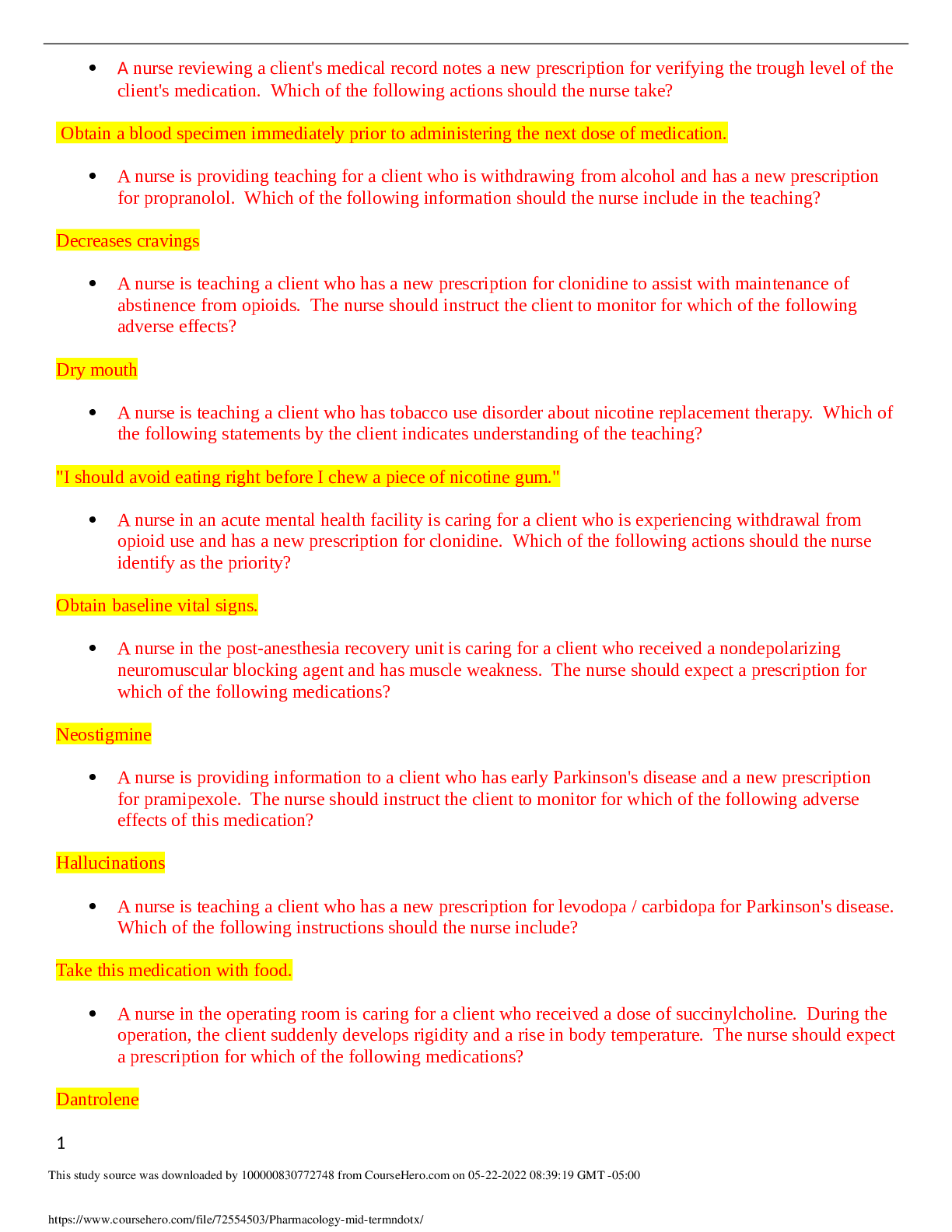
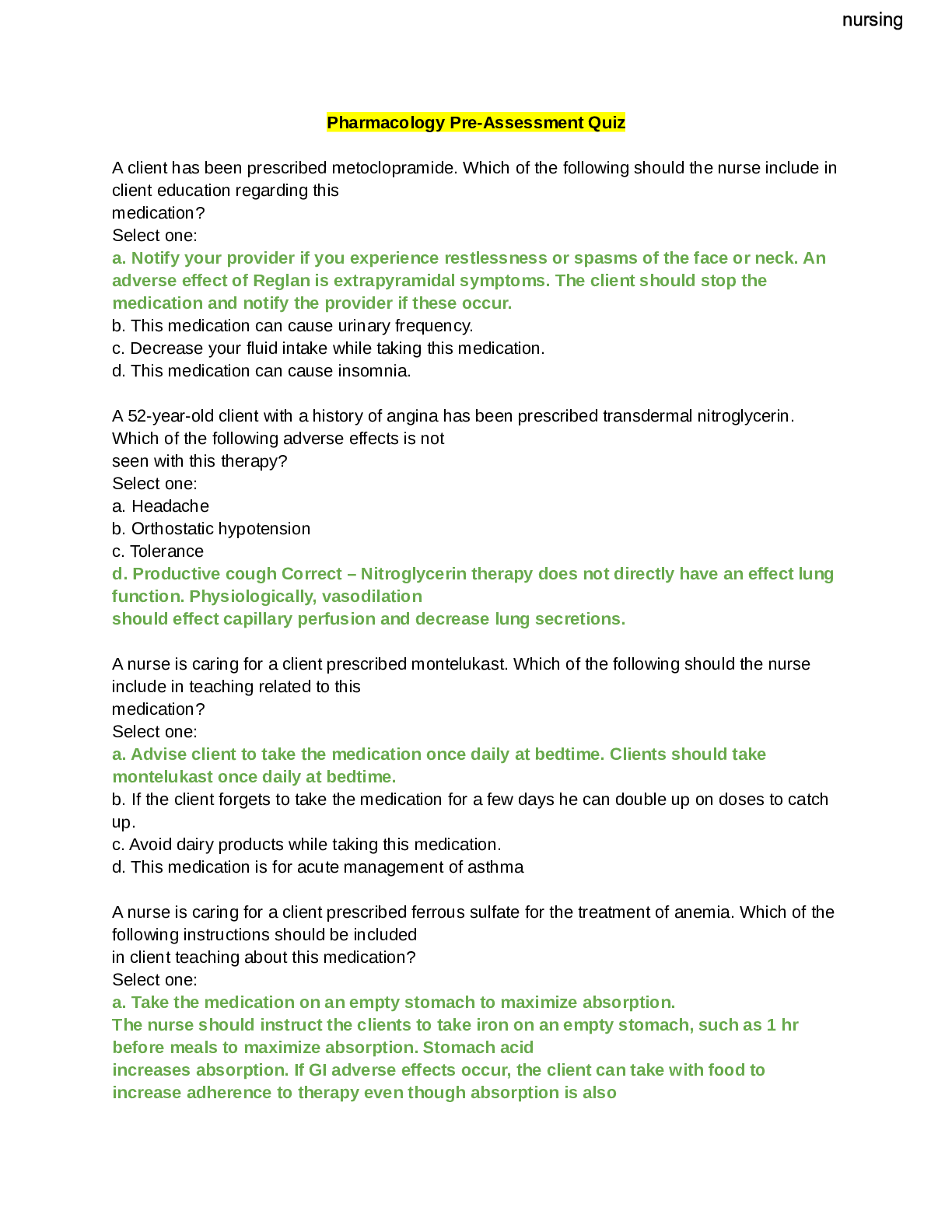

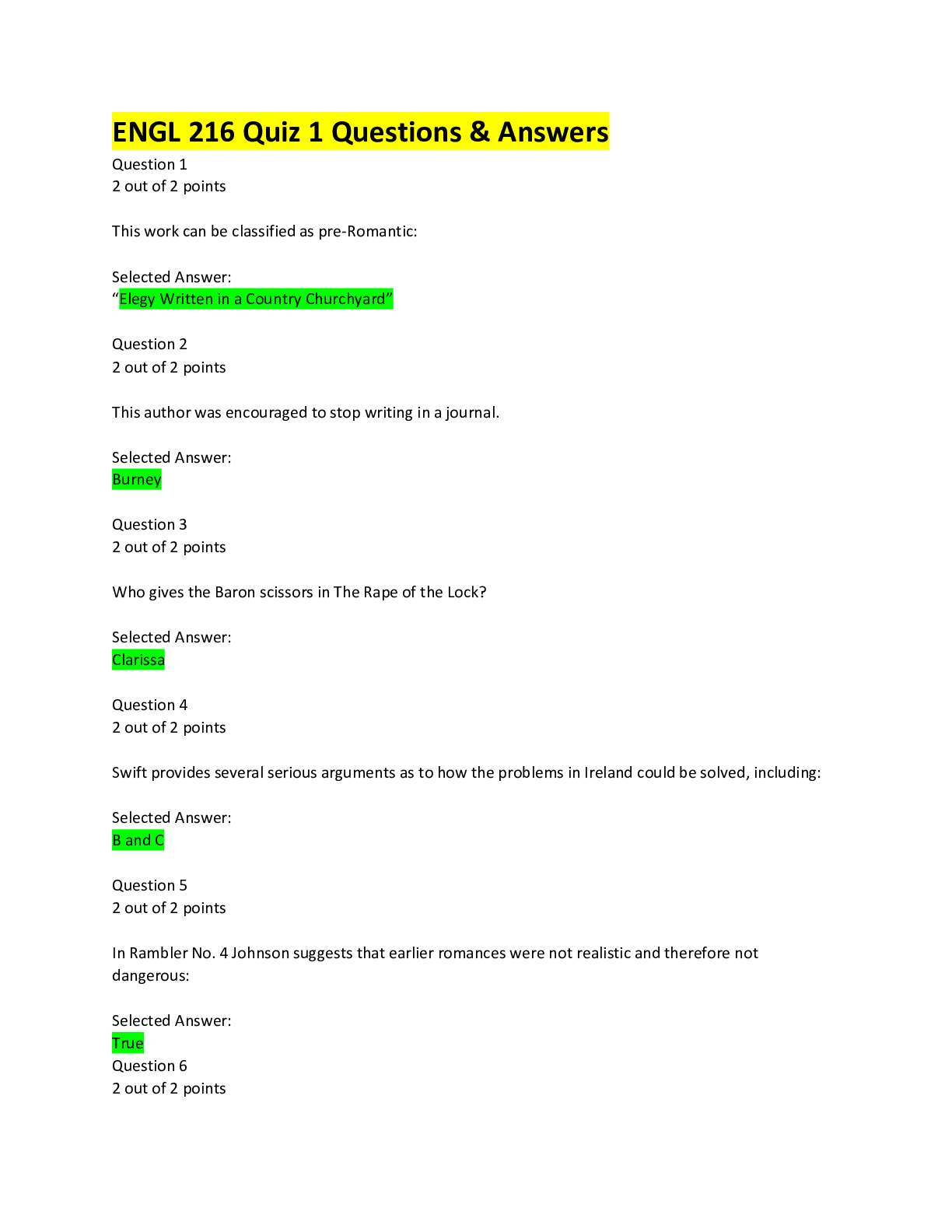

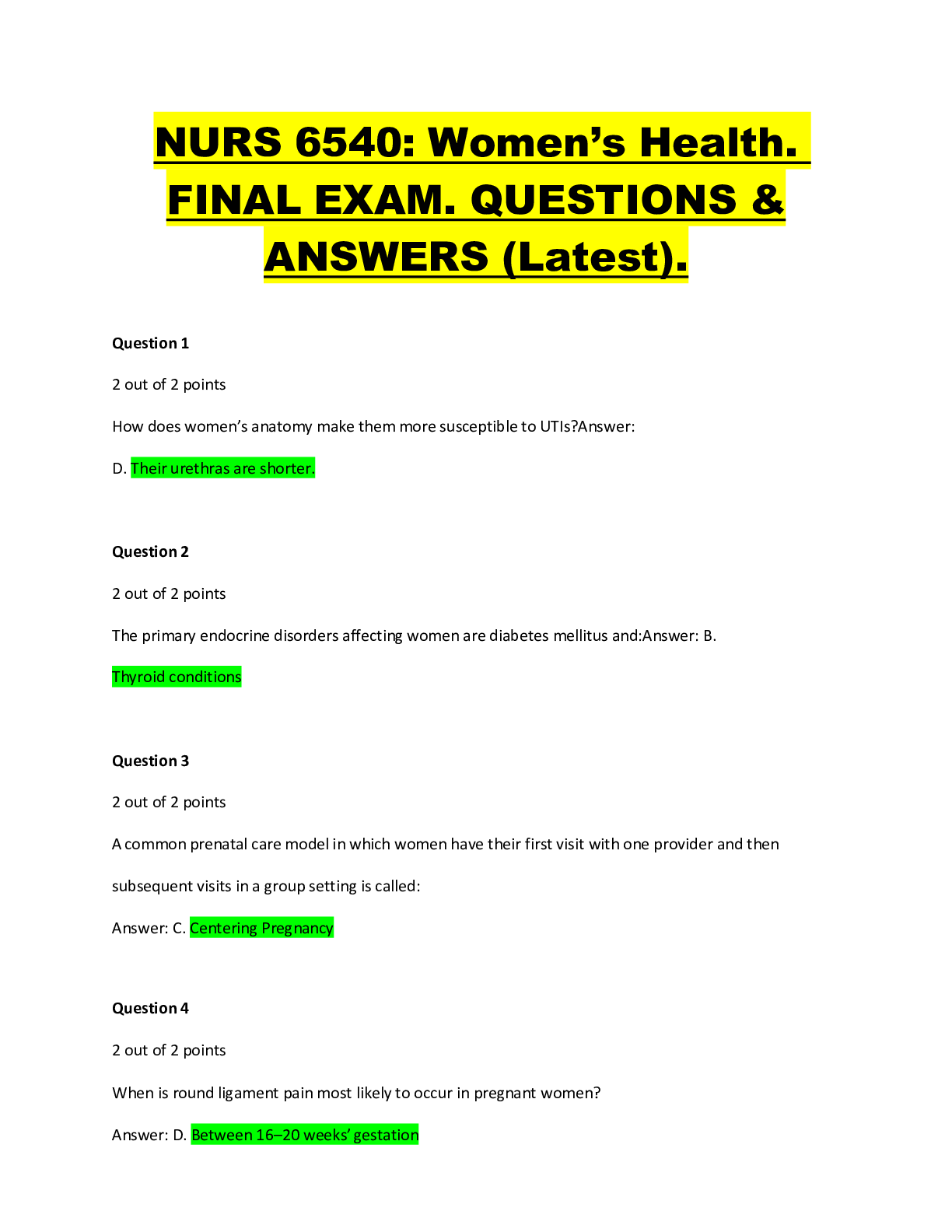
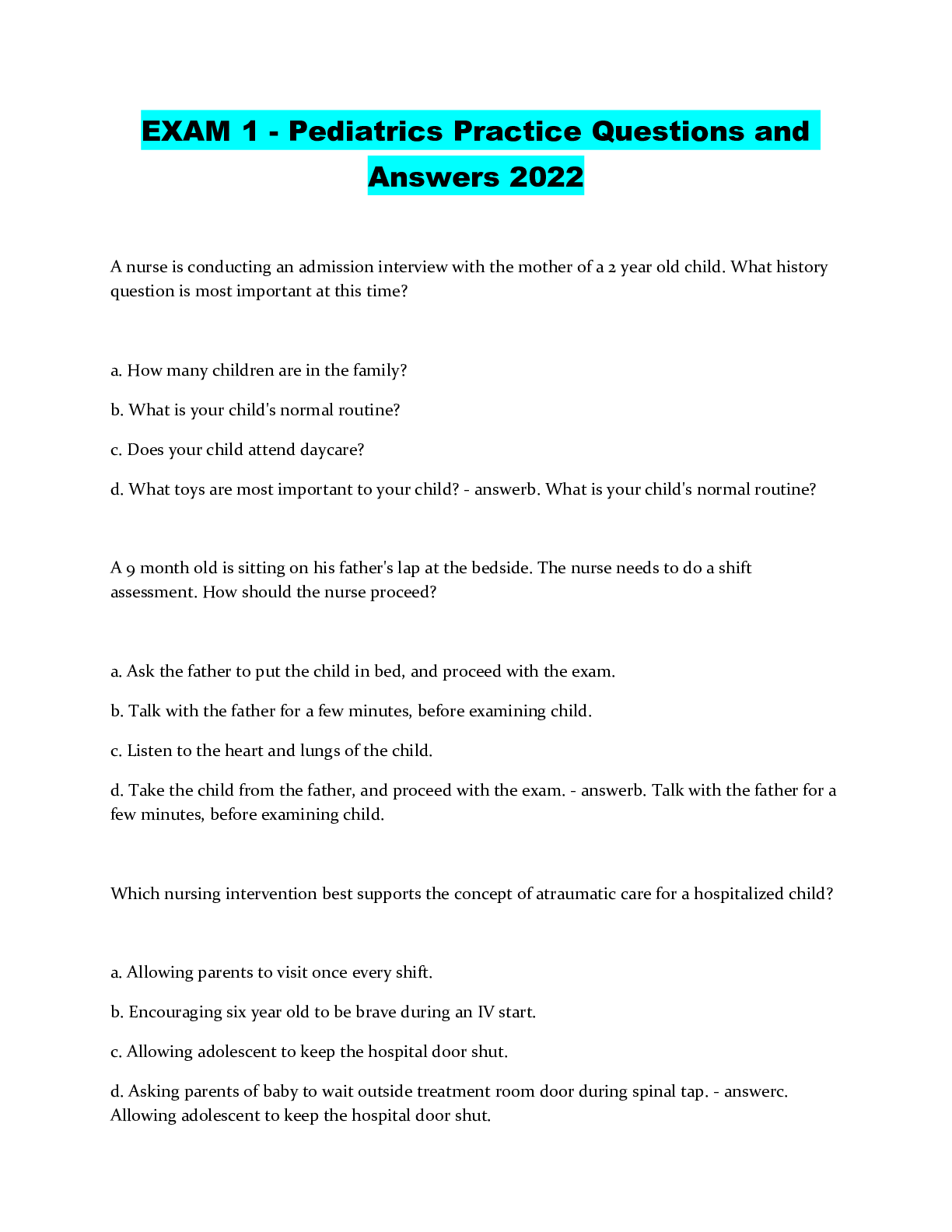

.png)
